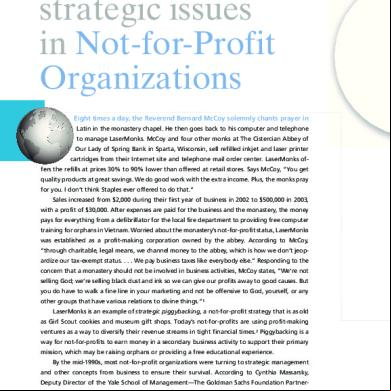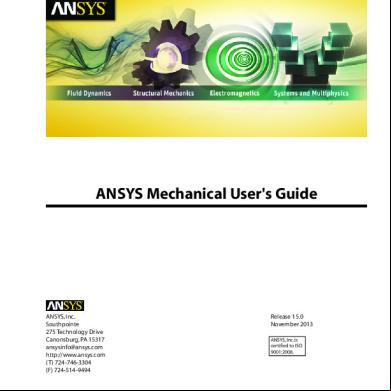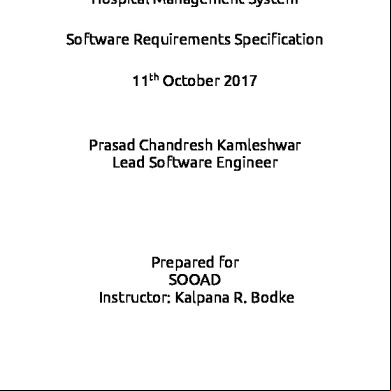Hsslive Xii ancy Ch1 Not For Profit Organization 6f1x4y
This document was ed by and they confirmed that they have the permission to share it. If you are author or own the copyright of this book, please report to us by using this report form. Report 3b7i
Overview 3e4r5l
& View Hsslive Xii ancy Ch1 Not For Profit Organization as PDF for free.
More details w3441
- Words: 1,281
- Pages: 4
ING FOR NOT-FOR-PROFIT ORGANISATION NOT-FOR-PROFIT ORGANISATION There are certain organisations which are set up for providing services to its and the public in general. Such organisations are called NOT-FOR-PROFIT ORGANISATION.
ING RECORDS OF NOT-FOR-PROFIT ORGANISATION Usually NOT-FOR-PROFIT ORGANISATION follow the cash system of ing. A NOT-FOR-PROFIT ORGANISATION prepares three statements at the end of the ing year, which form its final s. These statements are: 1. Receipt & Payment 2. Income & Expenditure 3. Balancesheet
Eg: Clubs, charitable institutions, schools, religious institutions trade unions, welfare societies etc. NOT-FOR-PROFIT ORGANISATION is defined as “a nonprofit seeking entity which does not usually involve in trading activities, but engage in rendering services to and society” Features of ing for not-for-profit organisation 1. Their main objective is to render services to its and the public 2. They don’t normally engage in trading activities 3. They are not expected to earn profit 4. Credit transactions are not usually made 5. No trail balance is prepared 6. Do not prepare Trading, Profit & Loss a/c 7. Their affairs are manages by executive committee elected by its
1
RECEIPT AND PAYMENT The Receipt and Payment is a real which is prepared at the end of an ing year giving a summary of all cash receipts and payments recorded in cash book. It is debited with all items of receipts and credited with all payments. At the end of the period, the is balanced. The final balance in this represents the balance of cash in hand or at the bank or overdraft. Features of Receipt and Payment
ing for Not-for-Profit Organisations- Aneesh.M (12032)
1. 2. 3. 4.
It is a real It is a summary of cash book All receipts are debited and payments are credited It usually begins with opening balance of cash in hand or at bank 5. It usually ends with closing balance of cash in hand or at bank 6. It doesn’t disclose the working results of the concern
1. Read the Receipt and payment thoroughly. 2. Exclude the opening and closing balances of cash and bank 3. Exclude the capital receipts and capital payments 4. Identify the revenue incomes relating to the current year from debit side of Receipt and payment 5. Identify the revenue expenditure relating to the current year from credit side of Receipt and payment 6. Non-Cash transactions (Depreciation, Provision of bad debts, accrued income, profit or loss on sale of fixed assets etc.) are adjusted in it. 7. Finally, the excess of income over expenditure (Surplus) or excess of expenditure over income (Deficit) be ascertained and transferred to Capital Fund.
7. It includes all receipts and payments of capital and revenue nature. 8. It records all receipts and payments relating to previous, current and subsequent years. INCOME & EXPENDITURE An Income and Expenditure is a nominal prepared by a non- Profit Organisation, in order to ascertain the surplus or deficit of a particular period. It is prepared in the form of Profit and Loss . All expenses and losses are debited and all incomes and gains are credited. The surplus or deficit is transferred to Capital Fund in the Balance sheet. Features of Income &Expenditure 1. It is a nominal 2. Only revenue items are recorded 3. Income and expenditure of the current year only are included. 4. Non-Cash transactions (Depreciation, Provision of bad debts, accrued income etc.) are adjusted in it. 5. There is no closing balance in this . 6. It is prepared to find out Surplus (Income over expenditure) or Deficit (Expenditure over income) 7. The surplus or deficit is transferred to Capital Fund in the Balance sheet.
BALANCE SHEET The balance sheet of a non-profit organisation is prepared for ascertaining the financial position of the organisation. It shows assets and liabilities as at the end of the year. Assets are shown on the right hand side and liabilities on the left hand side. The procedure in the preparation of balance sheet is as follows:
Preparation of Income and Expenditure The following steps are followed to prepare income and expenditure from receipt and payments . 1
ing for Not-for-Profit Organisations- Aneesh.M (12032)
1. Capital fund at the beginning is ascertained by preparing a statement of affairs(Opening Balance Sheet) 2. Surplus from Income and Expenditure must be added to the Capital Fund (Deficit must be deducted). 3. Outstanding expenses, income received in advance etc on closing date be shown on the liability side
4. Income receivable and expenses paid in advance etc must be shown on the assets side. 5. Closing cash in hand and at bank appearing in Receipts and Payments must be shown on the assets side. 6. The credit balance of Receipts and Payments (Bank Overdraft) should be shown on the liability side. 7. Assets in existence at beginning of the year should be adjusted for additions and depreciation 8. New assets acquired during the year which appear on the payment side of Receipts and Payments should be shown on the asset side of the closing balance sheet. 9. Any special collection of non-recurring nature (Capital Items) should be shown on the liability side.
year Non- cash transactions are not made Its closing balance is carried to the succeeding year.
Non- cash transactions are made Its balance (Surplus or Deficit) is transferred to Capital Fund. It records both revenue and It records only revenue capital items items. Calculation of the amount of Subscription credited to Income and Expenditure Particulars Subscription received during the year Add: Closing Subscription Outstanding Add: Opening Subscription Received in Advance
Receipts and Payments V\S Income and Expenditure Receipts and Payments Real Summary of cash book Its debit side shows receipts and credit side shows payments It starts with an opening balance of cash or bank It records all receipts and payments of previous year, current year and succeeding 1
Income and Expenditure Nominal Like a Profit and Loss Its debit side shows expenses and losses and credit side shows incomes and gains It doesn’t start with cash or bank balance It records income and expenses of current year only
Amount
(Rs.) xxx xxx xxx xxx xxx xxx xxx
Less: opening Subscription Outstanding Less: Closing Subscription Received in Advance The amount of Subscription credited to Income and Expenditure Subscription: Subscription is a hip fee paid by the member on annual basis. This is the main source of income of non-profit organisation. Subscription paid by is shown as receipt in Receipts and Payments . Legacy: it is the amount received by non-profit making organisations on the death of a person as per his “will”. It is usually a non-recurring nature (Capital Items) Donation: Donations are amounts receives by way of gift. It may
ing for Not-for-Profit Organisations- Aneesh.M (12032)
a) Specific Donations b) General Donations Calculation of the amount of Expenses debited to Income and Expenditure Particulars Expenses paid during the year Add: Closing Expenses Outstanding Add: Opening Expenses Paid in Advance
Less: opening Expenses Outstanding Less: Closing Expenses Paid in Advance The amount of Expenses debited to Income and Expenditure
Amount
(Rs.) xxx xxx xxx xxx xxx xxx xxx
Calculation of the amount of Stationery debited to Income and Expenditure Amount
Particulars Payment made for stationery during the year Add: Opening stock of Stationery Add: Amount due for stationery bought during the year Less: Closing stock of Stationery The amount of Stationery debited to Income and Expenditure
1
(Rs.) xxx xxx xxx xxx xxx xxx
ing for Not-for-Profit Organisations- Aneesh.M (12032)
ING RECORDS OF NOT-FOR-PROFIT ORGANISATION Usually NOT-FOR-PROFIT ORGANISATION follow the cash system of ing. A NOT-FOR-PROFIT ORGANISATION prepares three statements at the end of the ing year, which form its final s. These statements are: 1. Receipt & Payment 2. Income & Expenditure 3. Balancesheet
Eg: Clubs, charitable institutions, schools, religious institutions trade unions, welfare societies etc. NOT-FOR-PROFIT ORGANISATION is defined as “a nonprofit seeking entity which does not usually involve in trading activities, but engage in rendering services to and society” Features of ing for not-for-profit organisation 1. Their main objective is to render services to its and the public 2. They don’t normally engage in trading activities 3. They are not expected to earn profit 4. Credit transactions are not usually made 5. No trail balance is prepared 6. Do not prepare Trading, Profit & Loss a/c 7. Their affairs are manages by executive committee elected by its
1
RECEIPT AND PAYMENT The Receipt and Payment is a real which is prepared at the end of an ing year giving a summary of all cash receipts and payments recorded in cash book. It is debited with all items of receipts and credited with all payments. At the end of the period, the is balanced. The final balance in this represents the balance of cash in hand or at the bank or overdraft. Features of Receipt and Payment
ing for Not-for-Profit Organisations- Aneesh.M (12032)
1. 2. 3. 4.
It is a real It is a summary of cash book All receipts are debited and payments are credited It usually begins with opening balance of cash in hand or at bank 5. It usually ends with closing balance of cash in hand or at bank 6. It doesn’t disclose the working results of the concern
1. Read the Receipt and payment thoroughly. 2. Exclude the opening and closing balances of cash and bank 3. Exclude the capital receipts and capital payments 4. Identify the revenue incomes relating to the current year from debit side of Receipt and payment 5. Identify the revenue expenditure relating to the current year from credit side of Receipt and payment 6. Non-Cash transactions (Depreciation, Provision of bad debts, accrued income, profit or loss on sale of fixed assets etc.) are adjusted in it. 7. Finally, the excess of income over expenditure (Surplus) or excess of expenditure over income (Deficit) be ascertained and transferred to Capital Fund.
7. It includes all receipts and payments of capital and revenue nature. 8. It records all receipts and payments relating to previous, current and subsequent years. INCOME & EXPENDITURE An Income and Expenditure is a nominal prepared by a non- Profit Organisation, in order to ascertain the surplus or deficit of a particular period. It is prepared in the form of Profit and Loss . All expenses and losses are debited and all incomes and gains are credited. The surplus or deficit is transferred to Capital Fund in the Balance sheet. Features of Income &Expenditure 1. It is a nominal 2. Only revenue items are recorded 3. Income and expenditure of the current year only are included. 4. Non-Cash transactions (Depreciation, Provision of bad debts, accrued income etc.) are adjusted in it. 5. There is no closing balance in this . 6. It is prepared to find out Surplus (Income over expenditure) or Deficit (Expenditure over income) 7. The surplus or deficit is transferred to Capital Fund in the Balance sheet.
BALANCE SHEET The balance sheet of a non-profit organisation is prepared for ascertaining the financial position of the organisation. It shows assets and liabilities as at the end of the year. Assets are shown on the right hand side and liabilities on the left hand side. The procedure in the preparation of balance sheet is as follows:
Preparation of Income and Expenditure The following steps are followed to prepare income and expenditure from receipt and payments . 1
ing for Not-for-Profit Organisations- Aneesh.M (12032)
1. Capital fund at the beginning is ascertained by preparing a statement of affairs(Opening Balance Sheet) 2. Surplus from Income and Expenditure must be added to the Capital Fund (Deficit must be deducted). 3. Outstanding expenses, income received in advance etc on closing date be shown on the liability side
4. Income receivable and expenses paid in advance etc must be shown on the assets side. 5. Closing cash in hand and at bank appearing in Receipts and Payments must be shown on the assets side. 6. The credit balance of Receipts and Payments (Bank Overdraft) should be shown on the liability side. 7. Assets in existence at beginning of the year should be adjusted for additions and depreciation 8. New assets acquired during the year which appear on the payment side of Receipts and Payments should be shown on the asset side of the closing balance sheet. 9. Any special collection of non-recurring nature (Capital Items) should be shown on the liability side.
year Non- cash transactions are not made Its closing balance is carried to the succeeding year.
Non- cash transactions are made Its balance (Surplus or Deficit) is transferred to Capital Fund. It records both revenue and It records only revenue capital items items. Calculation of the amount of Subscription credited to Income and Expenditure Particulars Subscription received during the year Add: Closing Subscription Outstanding Add: Opening Subscription Received in Advance
Receipts and Payments V\S Income and Expenditure Receipts and Payments Real Summary of cash book Its debit side shows receipts and credit side shows payments It starts with an opening balance of cash or bank It records all receipts and payments of previous year, current year and succeeding 1
Income and Expenditure Nominal Like a Profit and Loss Its debit side shows expenses and losses and credit side shows incomes and gains It doesn’t start with cash or bank balance It records income and expenses of current year only
Amount
(Rs.) xxx xxx xxx xxx xxx xxx xxx
Less: opening Subscription Outstanding Less: Closing Subscription Received in Advance The amount of Subscription credited to Income and Expenditure Subscription: Subscription is a hip fee paid by the member on annual basis. This is the main source of income of non-profit organisation. Subscription paid by is shown as receipt in Receipts and Payments . Legacy: it is the amount received by non-profit making organisations on the death of a person as per his “will”. It is usually a non-recurring nature (Capital Items) Donation: Donations are amounts receives by way of gift. It may
ing for Not-for-Profit Organisations- Aneesh.M (12032)
a) Specific Donations b) General Donations Calculation of the amount of Expenses debited to Income and Expenditure Particulars Expenses paid during the year Add: Closing Expenses Outstanding Add: Opening Expenses Paid in Advance
Less: opening Expenses Outstanding Less: Closing Expenses Paid in Advance The amount of Expenses debited to Income and Expenditure
Amount
(Rs.) xxx xxx xxx xxx xxx xxx xxx
Calculation of the amount of Stationery debited to Income and Expenditure Amount
Particulars Payment made for stationery during the year Add: Opening stock of Stationery Add: Amount due for stationery bought during the year Less: Closing stock of Stationery The amount of Stationery debited to Income and Expenditure
1
(Rs.) xxx xxx xxx xxx xxx xxx
ing for Not-for-Profit Organisations- Aneesh.M (12032)










